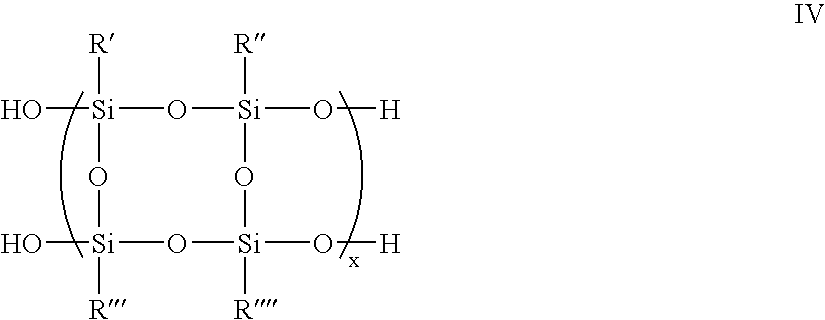Organosilane polymers, hardmask compositions including the same and methods of producing semiconductor devices using organosilane hardmask compositions
a technology of organosilane and hardmask composition, which is applied in the direction of instruments, photomechanical devices, optics, etc., can solve the problems of damage to the substrate, poor etch selectivity of arc material relative to imaging layer, and insufficient etch resistance of resist material, etc., to achieve sufficient resistance to multiple etchings, high etch selectivity, and minimal reflectivity
- Summary
- Abstract
- Description
- Claims
- Application Information
AI Technical Summary
Benefits of technology
Problems solved by technology
Method used
Image
Examples
example 1
[0076]
[0077]2,100 g of methyltrimethoxysilane and 340 g of phenyltrimethoxysilane were dissolved in 5,600 g of PGMEA in a 10-liter four-neck flask equipped with a mechanical agitator, a condenser, a dropping funnel and a nitrogen feed tube, and 925 g of an aqueous nitric acid (1,000 ppm) solution was added thereto. After the resulting solution was allowed to react at 60° C. for one hour, the formed methanol was removed under reduced pressure. The reaction was continued for one week while maintaining the reaction temperature at 50° C. After completion of the reaction, hexane was added to the reaction solution to obtain a precipitate. Separation of the precipitate afforded the desired polymer as a solid (Mw=15,000, polydispersity=4). 10 g of the polymer was dissolved in 100 g of PGMEA and 100 g of ethyl lactate to prepare a sample solution.
[0078]The sample solution was spin-coated onto a silicon wafer and baked at 200° C. for 60 seconds to produce a 600 Å-thick film.
example 2
[0079]
[0080]The above compound was prepared in the same manner as in Example 1, except that 1,750 g of methyltrimethoxysilane, 340 g of phenyltrimethoxysilane and 313 g of trimethoxysilane were used. A film was produced using the compound by the procedure described in Example 1.
example 3
[0081]
[0082]1,279 g of methyltrimethoxysilane, 310 g of phenyltrimethoxysilane, 288 g of trimethoxysilane and 523 g of methyltrimethoxysilylbutyrate were dissolved in 5,600 g of PGMEA in a 10-liter four-neck flask equipped with a mechanical agitator, a condenser, a dropping funnel and a nitrogen feed tube, and 833 g of an aqueous nitric acid (1,000 ppm) solution was added thereto. After the resulting solution was allowed to react at 60° C. for one hour, the formed methanol was removed under reduced pressure. The reaction was continued for one week while maintaining the reaction temperature at 50° C. After completion of the reaction, hexane was added to the reaction solution to obtain a precipitate. Separation of the precipitate afforded the desired polymer as a solid (Mw=23,000, polydispersity=4.6). 10 g of the polymer was dissolved in 100 g of PGMEA and 100 g of ethyl lactate to prepare a sample solution.
[0083]The sample solution was spin-coated on a silicon wafer and baked at 200°...
PUM
| Property | Measurement | Unit |
|---|---|---|
| Percent by mass | aaaaa | aaaaa |
| Percent by mass | aaaaa | aaaaa |
| Length | aaaaa | aaaaa |
Abstract
Description
Claims
Application Information
 Login to View More
Login to View More - R&D
- Intellectual Property
- Life Sciences
- Materials
- Tech Scout
- Unparalleled Data Quality
- Higher Quality Content
- 60% Fewer Hallucinations
Browse by: Latest US Patents, China's latest patents, Technical Efficacy Thesaurus, Application Domain, Technology Topic, Popular Technical Reports.
© 2025 PatSnap. All rights reserved.Legal|Privacy policy|Modern Slavery Act Transparency Statement|Sitemap|About US| Contact US: help@patsnap.com



